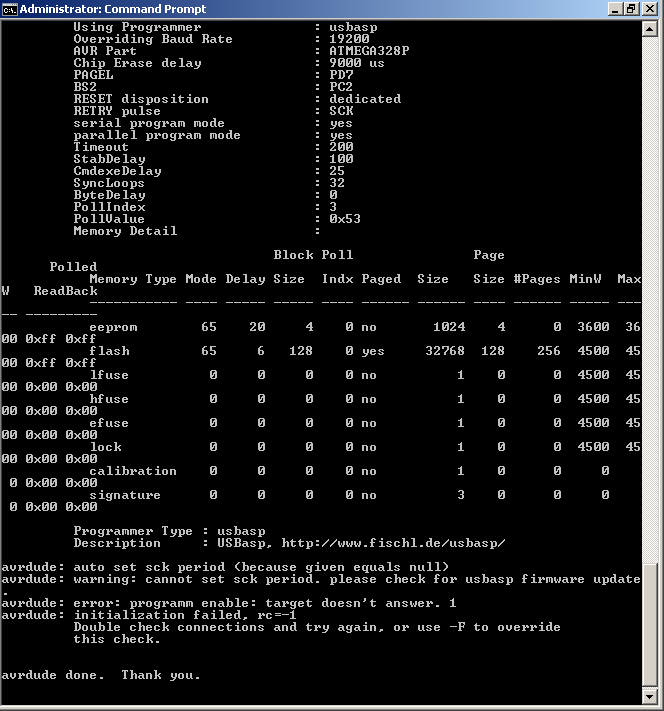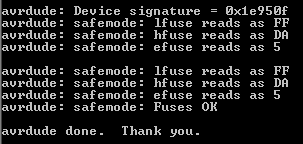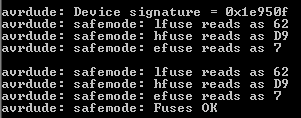Error flashing bootloader to atmega328p au board I design
-
@Mickey I'm just wondering why you would need a pull up of 56K, since the internal pullup resistor of those pins in the atmega328 is about the same value (somewhere between 30K and 50K according to datasheet). I see no need for R1.
-
@Mickey I'm just wondering why you would need a pull up of 56K, since the internal pullup resistor of those pins in the atmega328 is about the same value (somewhere between 30K and 50K according to datasheet). I see no need for R1.
@GertSanders said:
@Mickey I'm just wondering why you would need a pull up of 56K, since the internal pullup resistor of those pins in the atmega328 is about the same value (somewhere between 30K and 50K according to datasheet). I see no need to R1.
When I design the board I use the sensebender micro as reference. I did ask my self is it really needed but Deside to go with that but its not part of the problem...
-
@Mickey Correct, if electrically your board is OK, and you do not have a spare working Arduino board, you will need to use an AVR programmer to flash the bootloader.
-
@Mickey Correct, if electrically your board is OK, and you do not have a spare working Arduino board, you will need to use an AVR programmer to flash the bootloader.
@GertSanders said:
@Mickey Correct, if electrically your board is OK, and you do not have a spare working Arduino board, you will need to use an AVR programmer to flash the bootloader.
What is correct? I use an Avr programmer - Usbasp as I mention . I have a few working arduinos is it better to use them as a programmer? Can you tell me what values should I need to the fueses?
-
@Mickey As I do not have a AVR programmer, I flash my processors with my old Arduino. The fuses I use are the same I have in one of the earlier messages.
For me, the easiest way to work was to extend the sketch made by GAMMON (Atmega_Board_Programmer), but how I changed that sketch is a bit complicated to explain in a mail. I basically converted my bootloader HEX file into an ascii string, which I added in a '.h' file to his sketch. Then I hacked his code so that when I choose atmega328 I get my boatloader, instead of the default.
GAMMON's sketch also reprograms the fuses.
In his sketch I started with this change:
//#define USE_ATMEGA168 true
//#define USE_ATMEGA328P_8M true
#define USE_ATMEGA328P_8Mi true
//#define USE_ATMEGA328P trueanother piece of code I changed was this:
// ATmega328P
{ { 0x1E, 0x95, 0x0F },
0x7E00, // start address
#if USE_ATMEGA328P_8Mi
optiboot_atmega328_8Mhz_B0_hex, // loader image
sizeof optiboot_atmega328_8Mhz_B0_hex,
// 0xE2, // fuse low byte: internal clock, max start-up time
0xFF, // fuse low byte: external clock, max start-up time
0xDE, // fuse high byte: SPI enable, boot into bootloader, 512 byte bootloader
0x07, // fuse extended byte: brown-out detection off
#else
atmega328_optiboot,
sizeof atmega328_optiboot,
0xFF, // fuse low byte: external clock, max start-up time
0xDE, // fuse high byte: SPI enable, boot into bootloader, 512 byte bootloader
0x05, // fuse extended byte: brown-out detection at 2.7V
#endif
0x2F
}, // lock bits: SPM is not allowed to write to the Boot Loader section.I also added the attached '.h' file to his sketch:
optiboot_atmega328p_8M_B0.hFor me this is the fastest and most reliable way to flash my processors.
-
@Mickey: I think you have to change fuses. What I usually do is:
- program fuses with : avrdudess+usbasp.
you can check your fuse here: http://www.engbedded.com/fusecalc/ - Then copy atmega boards files, and you can use arduino ide to upload your bootloader, still with usbasp of course.
- Finally, you can bootload with ftdi.
But, adding atmega board files doesn't reprogram the fuses if I remember right. If it doesn't work like I explained, then maybe hardware connection..
On my side, I prefer usbasp/avrspi. it's very easy too, I think :smiley: most important is that it works :wink:
- program fuses with : avrdudess+usbasp.
-
@Mickey: I think you have to change fuses. What I usually do is:
- program fuses with : avrdudess+usbasp.
you can check your fuse here: http://www.engbedded.com/fusecalc/ - Then copy atmega boards files, and you can use arduino ide to upload your bootloader, still with usbasp of course.
- Finally, you can bootload with ftdi.
But, adding atmega board files doesn't reprogram the fuses if I remember right. If it doesn't work like I explained, then maybe hardware connection..
On my side, I prefer usbasp/avrspi. it's very easy too, I think :smiley: most important is that it works :wink:
@scalz said:
@Mickey: I think you have to change fuses. What I usually do is:
- program fuses with : avrdudess+usbasp.
you can check your fuse here: http://www.engbedded.com/fusecalc/ - Then copy atmega boards files, and you can use arduino ide to upload your bootloader, still with usbasp of course.
- Finally, you can bootload with ftdi.
But, adding atmega board files doesn't reprogram the fuses if I remember right. If it doesn't work like I explained, then maybe hardware connection..
On my side, I prefer usbasp/avrspi. it's very easy too, I think :smiley: most important is that it works :wink:
Hi
How can I change fuses if the avr programmer doesn't even detect the chip? when I runavrdude -b 19200 -c usbasp -p m328p -vI get

- program fuses with : avrdudess+usbasp.
-
Double check the connections. If the programmer does not see your processor, there is not much more that can be done on the software side. First check hardware again.
-
@scalz said:
@Mickey: I think you have to change fuses. What I usually do is:
- program fuses with : avrdudess+usbasp.
you can check your fuse here: http://www.engbedded.com/fusecalc/ - Then copy atmega boards files, and you can use arduino ide to upload your bootloader, still with usbasp of course.
- Finally, you can bootload with ftdi.
But, adding atmega board files doesn't reprogram the fuses if I remember right. If it doesn't work like I explained, then maybe hardware connection..
On my side, I prefer usbasp/avrspi. it's very easy too, I think :smiley: most important is that it works :wink:
Hi
How can I change fuses if the avr programmer doesn't even detect the chip? when I runavrdude -b 19200 -c usbasp -p m328p -vI get

- program fuses with : avrdudess+usbasp.
-
@Mickey Maybe you need to disconnect the radio. I am not able to use SPI programming with the radio connected...
@AWI said:
@Mickey Maybe you need to disconnect the radio. I am not able to use SPI programming with the radio connected...
I also thought that but I made another board without the radio with the same error.
I needed a fast way to figure it out so I desolder the atmega from an old arduino nano board but before I did it I read the fuses and got this:

then I soldered the virgin series I have and read the fuses:

so first of all It appears that I need the chips first hook up to an external clock just to be able to read the fuses and then change them.
